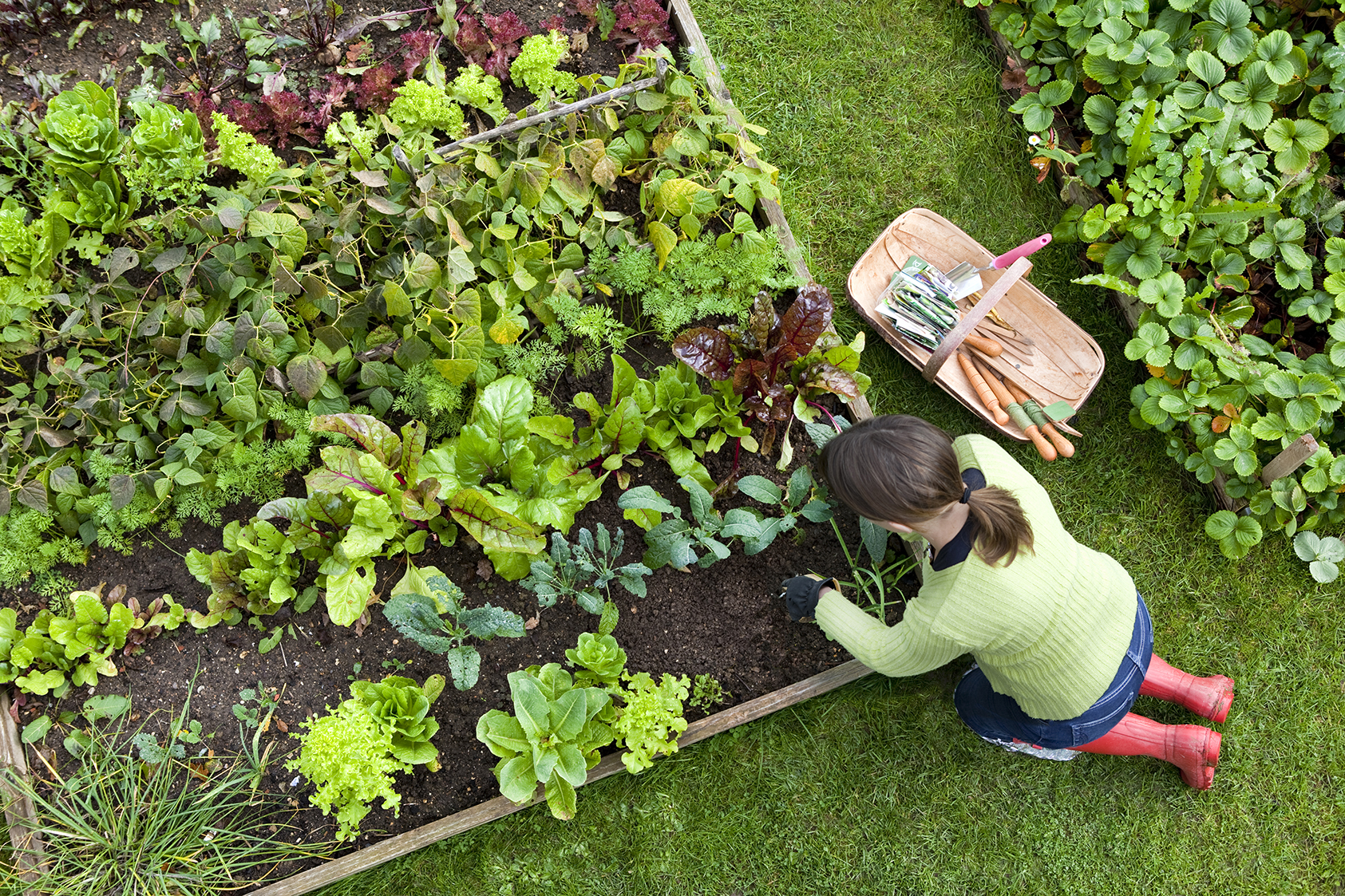Home>Pantry Storage>How To Start A Food Pantry


Pantry Storage
How To Start A Food Pantry
Modified: December 6, 2023
Learn how to start a food pantry and optimize your pantry storage with our helpful tips and guidelines. Create a well-organized pantry to keep your food items fresh and easily accessible.
(Many of the links in this article redirect to a specific reviewed product. Your purchase of these products through affiliate links helps to generate commission for Storables.com, at no extra cost. Learn more)
Introduction
Welcome to our comprehensive guide on starting a food pantry. In today’s society, there is an ever-increasing need to help those who are struggling with food insecurity. Food pantries play a crucial role in providing essential nourishment to individuals and families facing economic challenges.
If you have a desire to make a positive impact in your community and help combat hunger, starting a food pantry can be a rewarding endeavor. However, to ensure its success, it’s essential to approach the process with careful planning, strong partnerships, and the right resources.
In this article, we will walk you through the step-by-step process of establishing and running a food pantry. Whether you’re an individual, part of a community organization, or a business looking to give back, this guide will equip you with the knowledge and tools needed to create a sustainable and impactful food pantry.
Before we delve into the practical steps, let’s take a moment to understand the gravity of the issue at hand. Food insecurity affects millions of individuals worldwide, including developed nations like the United States. The impact of socioeconomic disparities, unforeseen circumstances, and natural disasters can leave many people vulnerable to hunger and inadequate nutrition.
A food pantry serves as a vital resource for those facing food insecurity. It not only provides essential food items but also helps foster a sense of community and support. By starting a food pantry, you can contribute to improving the well-being of individuals and families who are struggling to put food on their tables.
While starting a food pantry may seem like a daunting task, with the right guidance and proper planning, it can be a manageable and fulfilling endeavor. Throughout this guide, we will provide you with actionable steps, tips, and insights to help you navigate the process smoothly.
We encourage you to approach the establishment of a food pantry with dedication and passion. Starting a food pantry requires commitment, time, and effort. However, the rewards – a healthier community, gratitude from those you serve, and the knowledge that you are making a difference – far outweigh the challenges.
So, let’s dive in and explore how you can create an impactful food pantry that addresses the needs of your community.
Key Takeaways:
- Starting a food pantry requires thorough community needs assessment, strategic partnerships, and clear policies to address food insecurity effectively and sustainably.
- Successful food pantries rely on dedicated volunteers, strategic donation solicitation, efficient setup, and impactful promotion to make a positive impact on individuals and families in need.
Read more: How To Start A Community Garden
Step 1: Identify the Community’s Needs
The first step in starting a food pantry is to thoroughly assess and understand the needs of your community. By gaining insight into the specific challenges faced by individuals and families in your area, you can tailor your efforts to address these needs effectively.
Here are a few essential steps to guide you in identifying the community’s needs:
1. Research local statistics: Begin by researching statistics related to food insecurity in your community. Look for data on poverty rates, unemployment rates, and the number of individuals relying on food assistance programs. This information will give you a comprehensive understanding of the scope of the issue in your area.
2. Engage with community organizations and leaders: Reach out to local organizations, such as social service agencies, churches, schools, and community centers, to gather information on the specific challenges faced by individuals and families in your community. Discussing the issue with these key stakeholders will provide valuable insights and possible partnerships.
3. Conduct surveys and interviews: Design surveys or conduct interviews with community members to gather firsthand information about their experiences with food insecurity. Ask about access to nutritious food, dietary needs, and any challenges or barriers they face in obtaining food on a regular basis. This direct feedback will help you tailor your food pantry services to meet the specific needs of your community.
4. Consider vulnerable populations: Take into account any vulnerable populations in your community, such as children, seniors, individuals with disabilities, or those experiencing homelessness. These groups may have unique nutritional needs or face additional barriers to accessing food, and it’s important to ensure your food pantry can provide for them adequately.
5. Collaborate with healthcare professionals: Another valuable resource is healthcare professionals, such as doctors, nurses, and nutritionists, who work closely with individuals facing food insecurity. Seek their input on the health challenges brought on by inadequate nutrition and the specific food items that would benefit the community the most.
6. Analyze existing food assistance programs: Evaluate the effectiveness of existing food assistance programs in your area. Determine if their services are reaching everyone in need and identify any gaps or unaddressed needs. This analysis will help you ensure that your food pantry complements and enhances these programs rather than duplicating efforts.
By thoroughly understanding the specific needs of your community, you can develop a food pantry that provides targeted assistance and effectively addresses the underlying issues causing food insecurity. This knowledge will guide your decision-making process as you move forward in establishing a successful food pantry.
Step 2: Research Existing Food Pantries
Before starting your own food pantry, it’s important to research and familiarize yourself with existing food pantries in your area. Understanding what others are doing can provide valuable insights, help you identify any gaps in service, and allow for potential collaboration.
Here are some key steps to researching existing food pantries:
1. Conduct an online search: Begin your research by conducting an online search for food pantries in your local area. Look for websites or social media pages that provide information about their services, locations, and volunteer opportunities. Take note of the different approaches and services offered by each pantry.
2. Visit local food pantries: Take the time to visit local food pantries in person if possible. This will provide you with a firsthand experience of their operations, layout, and the services they provide. Engage with the staff and volunteers to learn about their challenges, successes, and any insights they can offer.
3. Interview pantry coordinators: Reach out to the coordinators of existing food pantries and request an interview to gather more information. Ask about their target demographics, the challenges they face, and any lessons they have learned. This will allow you to gain valuable insights from those who are already experienced in running a food pantry.
4. Identify gaps in service: During your research, identify any gaps or unmet needs within the existing food pantries. Look for areas where you can potentially fill a need or offer additional services. For example, if there are limited options for fresh produce, you may consider focusing on providing a variety of fruits and vegetables.
5. Explore potential partnerships: Consider potential partnerships with existing food pantries. Collaboration can be mutually beneficial, allowing for the sharing of resources, knowledge, and volunteer networks. Discuss the possibility of working together to address the food insecurity challenges in your community.
6. Learn from success stories: Look for success stories among existing food pantries. Identify the strategies and initiatives that have proven to be effective in addressing food insecurity. Adapt and incorporate these successful approaches into your own food pantry plan.
The research you conduct on existing food pantries will serve as a valuable foundation for your own food pantry. Learning from the experiences of others will help you avoid common pitfalls and make informed decisions as you move forward in establishing your own food pantry.
Step 3: Establish Partnerships
Establishing partnerships is a vital step in the process of starting a food pantry. Collaborating with other organizations, businesses, and individuals in your community can greatly enhance your ability to meet the needs of those facing food insecurity. By leveraging the strengths and resources of these partners, you can create a more robust and sustainable food pantry.
Here are some key steps to establish partnerships for your food pantry:
1. Identify potential partners: Start by identifying potential partners who share a similar mission or have resources that can complement your food pantry. This may include local businesses, faith-based organizations, schools, community centers, and nonprofit organizations focused on poverty alleviation or community development.
2. Reach out and explain your mission: Initiate contact with potential partners, either through email, phone calls, or in-person meetings. Clearly explain the mission and goals of your food pantry and how partnering with them can benefit both organizations and, ultimately, the community. Express your desire to collaborate and make a positive impact together.
3. Build relationships: Foster relationships with potential partners and establish a rapport based on trust and shared goals. Attend community events, meetings, and gatherings where you can network and interact with potential partners. Building strong relationships is crucial for long-term collaborations.
4. Explore shared initiatives: Identify common initiatives or projects where you can collaborate with partners. This might include organizing food drives, hosting fundraising events, coordinating volunteer efforts, or developing educational programs on nutrition and healthy eating. The more aligned your initiatives are, the stronger the partnership will be.
5. Leverage resources: Assess the resources that partners can bring to the table and determine how they can support your food pantry. This may include financial contributions, food donations, volunteer support, access to storage space, or assistance with marketing and promotion. Be open to exploring creative and mutually beneficial ways of leveraging each partner’s resources.
6. Formalize partnerships: Once you have established a solid foundation of trust and collaboration, consider formalizing partnerships through Memorandums of Understanding (MOUs) or partnership agreements. These documents outline the roles, responsibilities, and expectations of each partner and ensure a clear and transparent working relationship.
7. Maintain open communication: Regularly communicate and update your partners on the progress and impact of your food pantry. Provide them with opportunities to offer feedback, share ideas, and contribute to decision-making. Keeping the lines of communication open fosters a sense of ownership and investment in the success of the food pantry.
Remember, building partnerships is an ongoing process that requires nurturing and maintenance. Continuously seek out new opportunities for collaboration and cultivate existing relationships to create a strong network of partners who are committed to addressing food insecurity in your community.
Step 4: Determine Resources and Space
Before you can effectively run a food pantry, it’s crucial to determine the resources and space you will need to operate efficiently. Assessing your available resources and securing an appropriate space is essential for ensuring that you can meet the demands of your community in a sustainable manner.
Here are the key steps to determine the resources and space for your food pantry:
1. Assess your financial resources: Evaluate the financial resources available to you, whether it’s through fundraising efforts, grants, donations, or personal contributions. Having a clear understanding of your financial situation will help you determine what you can afford in terms of rent, utilities, and other operational expenses.
2. Identify potential funding sources: Research and explore potential funding sources that can provide ongoing financial support for your food pantry. This may include local government grants, corporate sponsorships, or partnerships with businesses and philanthropic organizations dedicated to addressing food insecurity.
3. Determine the size and layout requirements: Assess the amount of space you will need to effectively store and distribute food. Consider factors such as the volume of food donations you expect to receive, the number of individuals and families you plan to serve, and the layout needed for an organized and efficient operation. Ensure that your chosen space can accommodate your projected needs.
4. Seek out potential spaces: Start searching for spaces that meet your requirements. This may include scouting for available commercial spaces, unused community facilities, or even partnering with an existing organization that has the available space to accommodate a food pantry. Negotiate rental terms or partnership agreements that align with your financial capabilities.
5. Consider storage and refrigeration: Food pantries require proper storage and refrigeration to maintain the quality and freshness of food items. Assess the availability of storage facilities and refrigeration equipment in the chosen space or determine if you will need to invest in additional resources to meet these needs. Make sure you comply with food safety regulations and storage guidelines.
6. Determine transportation capabilities: Consider the transportation capabilities of your food pantry. Determine how you will collect and distribute food donations, whether it’s through your own vehicles, partnering with local transportation services, or coordinating with volunteers who can contribute their vehicles. Reliable transportation is essential to ensure a consistent supply of food.
7. Seek in-kind donations: Explore the possibility of securing in-kind donations for operational needs. This may include shelving units, pallets, storage bins, and office equipment. Reach out to local businesses, community organizations, or individuals who may be willing to contribute resources to support your food pantry.
8. Create a detailed inventory plan: Develop a detailed inventory plan to track incoming and outgoing food items, ensuring that you have a proper system in place for managing food supplies. This will help you avoid food waste and ensure that you are providing a variety of nutritious options to those in need.
Taking the time to assess your resources and secure an appropriate space will set the foundation for a successful and sustainable food pantry. By adequately preparing in this stage, you can ensure that your food pantry can fulfill its purpose of addressing food insecurity in your community effectively.
Read more: How To Organize Small Pantry Cabinet
Step 5: Develop a Plan and Set Goals
Developing a comprehensive plan and setting clear goals are essential steps in starting a food pantry. A well-thought-out plan will guide your operations and provide a roadmap for achieving your desired outcomes. Setting goals will help you measure your progress and ensure that you are making a meaningful impact on food insecurity in your community.
Here are the key steps to develop a plan and set goals for your food pantry:
1. Define your mission and vision: Clearly articulate the mission and vision of your food pantry. What is the purpose of your organization? What impact do you want to make? This will serve as the guiding principle for all your activities and decision-making.
2. Conduct a SWOT analysis: Perform a SWOT (Strengths, Weaknesses, Opportunities, and Threats) analysis to assess the internal and external factors that can influence your food pantry’s success. Identify your strengths that can be leveraged, weaknesses that need to be addressed, opportunities for growth, and potential threats that may hinder your progress.
3. Set specific, measurable, achievable, relevant, and time-bound (SMART) goals: Establish SMART goals that align with your mission. For example, set goals for the number of individuals or families you want to serve, the percentage of nutritious food to be distributed, or the volunteer hours you aim to achieve. Be realistic and set attainable targets.
4. Develop strategies and action plans: Create strategies and action plans to guide your operations towards achieving your goals. Break down your goals into smaller, manageable tasks and assign responsibilities to individuals or teams. Ensure that your strategies align with your available resources and the needs of your community.
5. Establish partnerships and collaborations: Identify potential partners and collaborations that can support your food pantry in achieving its goals. This may include partnering with local farms for fresh produce, collaborating with educational institutions for nutrition education programs, or working with employment agencies to provide job resources to your clients.
6. Create a budget and financial plan: Develop a budget to estimate your expenses and revenue sources. Consider costs such as rent, utilities, food purchases, transportation, staff or volunteer compensation, marketing, and any necessary certifications. Determine how you will raise funds and ensure the financial sustainability of your food pantry.
7. Establish monitoring and evaluation mechanisms: Put in place systems to monitor and evaluate your progress towards your goals. Regularly assess and track metrics such as the number of individuals served, donation levels, volunteer engagement, and client satisfaction. Continuously review and adjust your strategies based on this feedback.
8. Communicate your plan to stakeholders: Share your plan and goals with key stakeholders such as volunteers, donors, partners, and the community. Clearly communicate how their support and contributions will help you achieve your mission and make a meaningful impact on food insecurity. Keep stakeholders informed about your progress and celebrate milestones together.
Developing a plan and setting goals will provide direction and focus to your food pantry. Regularly review and update your plan as your organization evolves and adapts to the changing needs of your community. With a well-crafted plan in place, you will be on your way to creating a sustainable and impactful food pantry.
Consider partnering with local grocery stores, farms, and food distributors to source donations. Building these relationships can help ensure a steady supply of food for your pantry.
Step 6: Create Policies and Procedures
Creating clear and effective policies and procedures is crucial for the smooth operation of your food pantry. Policies and procedures provide guidelines and structure to ensure consistent and efficient practices in serving those facing food insecurity. They also help maintain the safety, integrity, and professionalism of your organization. Here are the key steps to create policies and procedures for your food pantry:
1. Establish a team: Assemble a team of individuals who will be responsible for creating the policies and procedures. This team may include staff members, volunteers, and key stakeholders who have experience and expertise in food safety, operations, and management.
2. Identify the areas that require policies and procedures: Determine which areas of your food pantry operation require written policies and procedures. This typically includes areas such as eligibility criteria for clients, food handling and safety protocols, volunteer responsibilities, client confidentiality, inventory management, and distribution procedures.
3. Research best practices: Conduct research to understand the best practices and industry standards in the areas you identified. Look for resources from reputable sources such as government agencies, food safety organizations, and other established food pantries. Incorporate these best practices into your policies and procedures to ensure that your food pantry operates at a high standard.
4. Develop clear and concise policies: Write clear and concise policies that outline the rules and expectations for each area of your food pantry. Consider using a standardized format that includes a policy statement, purpose, scope, responsibilities, and any necessary procedures or guidelines. Use language that is easy to understand and accessible to all stakeholders.
5. Address legal and regulatory requirements: Familiarize yourself with the legal and regulatory requirements that apply to food pantries in your jurisdiction. Ensure that your policies and procedures comply with these requirements to maintain legal and ethical practices. This may include obtaining necessary licenses, adhering to food safety regulations, and maintaining proper documentation.
6. Emphasize food safety: Develop comprehensive food safety protocols to maintain the quality and safety of the food you distribute. Include guidelines for receiving, storing, sorting, and distributing food items. Define proper hygiene practices, temperature control measures, and guidelines for handling perishable and non-perishable items. Regularly train and educate your staff and volunteers on food safety practices.
7. Involve key stakeholders: Seek input from key stakeholders, including volunteers, staff, and community members, when developing your policies and procedures. Their input can help identify potential challenges, provide valuable insights, and ensure that the policies effectively meet the needs of your food pantry and community.
8. Communicate and train: Once your policies and procedures are finalized, communicate them to all stakeholders. Conduct training sessions to ensure that everyone involved in your food pantry understands and follows the established guidelines. Regularly review and update your policies as needed to respond to changes in regulations, practices, or community needs.
Creating clear policies and procedures will help maintain consistency, professionalism, and the highest standards of service in your food pantry. Regularly evaluate and update your policies as your organization evolves and adapts to better serve those facing food insecurity.
Step 7: Gather Volunteers
Gathering volunteers is key to the success of your food pantry. Volunteers not only provide the necessary manpower to run daily operations but also bring diverse skills, experiences, and a sense of community to your organization. Here are the steps to gather volunteers for your food pantry:
1. Clearly define volunteer roles: Identify the specific roles and responsibilities needed in your food pantry. This can include tasks such as sorting and stocking food, assisting with distribution, administrative support, fundraising, marketing, and outreach. Break down these roles into detailed job descriptions to help potential volunteers understand the expectations and requirements.
2. Develop a recruitment strategy: Determine the most effective ways to reach potential volunteers. Utilize various channels such as social media platforms, community bulletin boards, local newspapers, and online volunteer databases. Consider partnering with local schools, religious organizations, and community groups to spread the word about volunteer opportunities at your food pantry.
3. Create compelling volunteer opportunities: Craft compelling volunteer opportunities that clearly communicate the impact volunteers can make in combatting food insecurity. Highlight the rewards and benefits of volunteering, such as personal growth, meaningful connections, and the satisfaction of helping others. Make it clear that volunteers of all backgrounds and skill levels are welcome and needed.
4. Establish a volunteer application process: Develop a streamlined volunteer application process. This may include an online application form or downloadable form that collects essential information about applicants, such as their contact details, availability, skills, and interests. Consider implementing a background check or screening process, especially for roles that involve working closely with vulnerable populations.
5. Provide volunteer training and orientation: Once volunteers are recruited, provide them with comprehensive training and orientation sessions. Cover topics such as the mission and values of your food pantry, safety guidelines, food handling protocols, client interactions, and any necessary technical or operational training. Ensure that volunteers feel confident and equipped to fulfill their roles effectively.
6. Foster a positive volunteer environment: Maintain a positive and inclusive volunteer environment. Encourage teamwork, respect, and open communication among volunteers. Recognize and appreciate their contributions through regular expressions of gratitude and opportunities for personal and professional development. Create a sense of belonging and community by organizing social events or volunteer appreciation activities.
7. Provide ongoing support and supervision: Continuously support and supervise your volunteers to ensure their engagement and satisfaction. Assign volunteer coordinators or supervisors who can address questions, provide guidance, and offer mentorship. Regularly check in with volunteers to assess their experiences, address concerns, and seek feedback on how to improve the volunteer program.
8. Recognize and celebrate volunteers: Recognize and celebrate the efforts and impact of your volunteers. Highlight their contributions through volunteer spotlights on your website or social media platforms. Organize regular appreciation events or awards to acknowledge their hard work and dedication. Showing gratitude helps foster a positive volunteer culture and encourages long-term commitment.
Remember, volunteers are the lifeblood of your food pantry. By creating meaningful and engaging volunteer opportunities, providing necessary support and recognition, and maintaining a positive volunteer environment, you will build a dedicated team that will help your food pantry thrive in serving those in need.
Step 8: Solicit Donations
Soliciting donations is a crucial step in ensuring the sustainability of your food pantry. By effectively reaching out to donors, you can secure the necessary resources to provide food assistance to individuals and families facing food insecurity. Here are the steps to solicit donations for your food pantry:
1. Identify potential donors: Begin by identifying potential donors who may be interested in supporting your cause. This can include individuals, businesses, philanthropic organizations, religious institutions, community groups, and local foundations. Research and compile a list of potential donors in your community.
2. Craft a compelling message: Develop a compelling message that communicates the importance and impact of your food pantry’s work. Clearly articulate how donations will directly help individuals and families in your community. Share stories and testimonials that highlight the real-life impact of your services. Emphasize the pressing need for support in fighting food insecurity.
3. Create a donation campaign: Establish a donation campaign with a clear goal and timeframe. This can be an ongoing campaign or one tied to a specific event or holiday. Create a sense of urgency and motivate potential donors to act. Develop a campaign theme and brand identity to make it memorable and visually appealing.
4. Utilize multiple channels: Utilize various channels to solicit donations. Leverage your website by prominently displaying a “Donate” button that links to a secure online donation platform. Utilize social media to raise awareness, share updates on your food pantry’s impact, and encourage followers to donate. Also, consider traditional methods such as direct mail or organizing fundraising events.
5. Appeal to local businesses: Approach local businesses for support. Offer options for corporate sponsorships, event sponsorships, or in-kind donations. Highlight the positive impact of their support on the local community and consider offering recognition through promotional materials or on your website.
6. Establish partnerships: Seek out strategic partnerships with local grocery stores, restaurants, farmers, and food distributors. Ask if they would be willing to donate surplus or unsold food items. This can help minimize food waste while providing nutritious options for those in need. Clearly communicate the benefits of donating to their businesses.
7. Launch targeted fundraising campaigns: Create targeted fundraising campaigns that align with specific donor interests. For instance, you can launch a campaign focused on providing fresh produce, baby formula, or holiday meal boxes. Tailoring your campaigns to specific needs helps donors feel connected and invested in the cause.
8. Cultivate relationships with donors: Nurture relationships with donors through regular communication and updates. Send personalized thank-you letters or emails to express gratitude for their support. Provide them with impact reports, showcasing how their donations are making a difference. Maintain open lines of communication to keep donors engaged and informed.
9. Explore matching gift programs: Research matching gift programs through local businesses or corporate foundations. These programs can significantly increase the value of donations as they match a portion or the full amount contributed by the donor. Promote matching gift opportunities to encourage donors to take advantage of this additional support.
10. Recognize and acknowledge donors: Publicly recognize and acknowledge the generosity of donors. Highlight their contributions on your website, newsletters, or social media platforms. Consider creating a donor appreciation wall or hosting an annual donor recognition event to express gratitude for their ongoing support.
Soliciting donations requires a strategic and compassionate approach. By effectively conveying the importance of your food pantry’s work, engaging multiple channels, cultivating relationships with donors, and showing appreciation, you will build a network of support that fuels your efforts in fighting food insecurity.
Step 9: Set Up the Pantry
Setting up your food pantry involves organizing the physical space and creating efficient systems to receive, store, and distribute food to individuals and families in need. Proper setup ensures that your pantry operates smoothly and effectively. Here are the steps to set up your food pantry:
1. Determine the layout: Assess the available space and design a layout that allows for easy movement and efficient workflow. Consider factors such as the flow of people, storage areas, refrigeration, and space for client registration and distribution.
2. Create storage systems: Establish storage systems to categorize and organize food items. Use shelving units, bins, and labels to separate different types of food, such as canned goods, dry goods, and fresh produce. Consider implementing a first-in, first-out (FIFO) system to ensure proper rotation of food items and minimize waste.
3. Ensure proper food handling practices: Implement food safety practices to maintain the quality and safety of the food distributed. Train volunteers on proper food handling techniques, including hygiene, temperature control, and storage guidelines. Educate them on food expiration dates and procedures for dealing with expired or damaged items.
4. Set up refrigeration and freezer systems: If your pantry will handle perishable items, ensure you have appropriate refrigeration and freezer systems. Establish proper temperature control measures and monitor equipment regularly to maintain food safety standards. Arrange the storage of perishable items in a way that allows for easy access and rotation.
5. Create a client registration system: Develop a client registration system to capture important information and track the individuals and families you serve. Determine the necessary information to gather, such as demographics, household size, and specific dietary or allergy considerations. Ensure you have appropriate confidentiality measures in place to protect client information.
6. Establish distribution procedures: Create efficient distribution procedures to ensure a smooth and organized process. Determine the days and hours of distribution, establish guidelines for clients to follow, and develop a system for managing queues to avoid overcrowding and maintain order. Consider implementing appointment-based or self-shopping models to personalize the experience for clients.
7. Train volunteers on pantry operations: Provide comprehensive training to volunteers on the operations of the food pantry. Train them on how to handle client interactions with sensitivity and respect. Educate them on the pantry’s policies, procedures, and safety guidelines. Regularly communicate updates and provide ongoing support and supervision as needed.
8. Develop communication channels: Implement effective communication channels to keep volunteers, clients, and donors informed. Utilize technology such as email newsletters, social media platforms, or a website to share updates, promote events, and express gratitude to donors. Ensure that the lines of communication are open for feedback and suggestions.
9. Incorporate signage and labeling: Use clear signage and labeling throughout the pantry to guide volunteers and clients. Label shelves, bins, and areas to indicate the types of food items or specific food categories. Include clear instructions and guidelines to help individuals navigate the pantry and make the distribution process smoother.
10. Regularly review and improve: Continuously review and evaluate your pantry’s setup and operations. Seek feedback from volunteers and clients to identify areas for improvement. Adjust the layout, systems, or processes as needed to enhance efficiency, address challenges, and better meet the needs of your community.
By thoughtfully setting up your food pantry, you create an environment that fosters efficiency, safety and ensures a positive experience for volunteers and clients. Regularly review and assess your setup to maintain an organized and effective operation.
Step 10: Promote the Food Pantry
Promoting your food pantry is crucial to raising awareness, attracting volunteers, and garnering support from the community. Effective promotion allows you to reach a wider audience and ensure that those facing food insecurity are aware of the resources you offer. Here are the steps to promote your food pantry:
1. Develop a marketing strategy: Create a comprehensive marketing strategy that outlines your goals, target audience, messaging, and promotional tactics. Consider both online and offline channels to optimize your reach and engage with diverse segments of the community.
2. Establish an online presence: Create a website for your food pantry that provides essential information about your services, mission, and contact details. Optimize your website for search engines to improve visibility. Utilize social media platforms to share updates, success stories, and volunteer opportunities to engage with your audience.
3. Leverage social media: Utilize various social media channels to amplify your message. Regularly post content related to your food pantry’s initiatives, volunteer activities, and testimonials from those you have served. Engage with your followers by responding to comments, sharing relevant news articles, and posting relevant information on food security and nutrition.
4. Engage local media: Develop relationships with local media outlets including newspapers, radio stations, and television networks. Pitch stories and share press releases about events, campaigns, or impactful community initiatives. Consider hosting press conferences or inviting journalists to cover your food pantry’s activities.
5. Collaborate with community partners: Partner with local businesses, community organizations, and schools to amplify your reach. Develop mutually beneficial collaborations where you can promote each other’s initiatives. For example, ask local restaurants to feature a donation drive or display informational materials about your food pantry.
6. Host fundraising events: Organize fundraising events to raise funds and awareness for your food pantry. Consider events such as food drives, charity walks or runs, community meals, or online fundraising campaigns. Engage volunteers and community members to participate and spread the word about your food pantry’s initiatives.
7. Utilize word-of-mouth marketing: Encourage volunteers and satisfied clients to spread the word about your food pantry to their friends, family, and colleagues. Share success stories that highlight the impact of your services, and provide easy-to-share social media posts or printable materials that supporters can distribute to help raise awareness.
8. Collaborate with influencers and ambassadors: Identify local influencers and community leaders who may be willing to support your food pantry’s cause. Reach out to them for collaboration opportunities, such as endorsing your food pantry on their social media platforms or participating in fundraising events.
9. Attend community events and fairs: Participate in local community events, fairs, and festivals to showcase your food pantry. Set up informational booths, distribute brochures or pamphlets, and engage with attendees to share information about your services. Use these opportunities to build relationships and connections in the community.
10. Show appreciation and recognize donors: Publicly acknowledge and express gratitude to your donors and supporters. Send thank-you letters or personalized notes to appreciate their contributions. Highlight their generosity on social media, your website, or newsletters. By recognizing their support, you encourage ongoing engagement and inspire others to get involved.
Promotion plays a vital role in raising awareness and support for your food pantry. By implementing effective marketing strategies and engaging with your community, you can increase visibility, attract volunteers, and secure necessary resources to continue combating food insecurity and making a positive impact in the lives of those in need.
Conclusion
Starting a food pantry is a rewarding endeavor that allows you to address the pressing issue of food insecurity in your community. By following the comprehensive steps outlined in this guide, you can establish a sustainable and impactful food pantry that provides crucial nourishment to individuals and families in need.
Throughout the process, it’s essential to maintain a people-centric approach, considering the unique needs of your community and ensuring that your efforts are driven by empathy, compassion, and a commitment to making a positive difference.
From identifying the specific needs of your community to researching existing food pantries, each step enhances your understanding and prepares you for success. Establishing partnerships with community organizations, securing appropriate resources and space, and developing clear policies and procedures provide the essential framework for effective operations. Gathering dedicated volunteers, soliciting donations, setting up the pantry, and promoting your food pantry expand your reach and ensure the sustainability of your efforts.
Remember that the journey of running a food pantry requires ongoing evaluation, adaptation, and collaboration. Continuously monitor your pantry’s impact, seek feedback from volunteers and clients, and foster strong relationships with donors and community partners. This commitment to growth and improvement will ensure that your food pantry remains responsive to the changing needs of those you serve.
Above all, your efforts make a tangible difference in the lives of individuals and families facing food insecurity. Your food pantry becomes a beacon of hope, providing not only access to nutritious meals but also creating a sense of community, support, and empowerment.
Starting a food pantry is a noble and impactful undertaking, and it is with great admiration for your dedication that we conclude this guide. By following these steps, you are stepping into a role that will make a lasting impact on the lives of many. So, roll up your sleeves, gather your team, and embark on this rewarding journey to make a difference in your community. Together, we can create a future where no one goes hungry.
Frequently Asked Questions about How To Start A Food Pantry
Was this page helpful?
At Storables.com, we guarantee accurate and reliable information. Our content, validated by Expert Board Contributors, is crafted following stringent Editorial Policies. We're committed to providing you with well-researched, expert-backed insights for all your informational needs.














0 thoughts on “How To Start A Food Pantry”